#Ashtanga Yoga sequences
Explore tagged Tumblr posts
Text
Silva siblings yoga head canons
I can't really practice yoga now, because of my leg and I miss it dearly. So I decided to share these few head canons I have for the birds ^^
Art which came to be during a conversation with @t-f-t below.
Definitions taken from this website to explain to you a bit.
Nozel Silva
Ashtanga
Ashtanga yoga consists of six series of specific poses taught in order. Each pose and each series is “given” to a student when their teacher decides they have mastered the previous one. This is a very physical, flow-style yoga with spiritual components.
The whole practice and system of Ashtanga fits Nozel really well in my opinion. He likes discipline, he likes patterns and this is a also a physical practice. You are getting stronger, through working on yourself and one very specific aspects. Ashtanga greatly focuses on details and how well you perform the sequence.
Solid Silva
Vinyasa
Vinyasa yoga is also called “flow yoga” or “vinyasa flow”. “Vinyasa flow is a style of yoga where the poses are synchronised with the breath in a continuous rhythmic flow.”
Solid would probably get bore with different types, while Vinyasa is the most lively one. Besides there is the flow that a water magic user would have. In Vinyasa you also learn some fun poses and it's very dynamic. It fits his much more "jumpy" character.
Nebra Silva
Hot yoga, but in Vinyasa not Bikram style.
For Nebra I also choose a more dynamic style. She's got that spark and sassiness and wants the freedom Vinyasa could grant her. However since her attribute is mist a high temperature would be a nice addition. She could wear some an amazing yoga shorts and top set and obviously would get a fancy mat, on which she would not slip on.
Noelle Silva
Aerial yoga
Aerial yoga — sometimes called anti-gravity yoga — is relatively new, but quickly catching on. It involves traditional yoga poses with the added support of a strong, silky hammock that hangs from the ceiling. Nontraditional yoga experience.
Nontraditional is the definition of Noelle after all. She's fighting the "gravity" of expectations towards her and rising above them. However she uses classical water magic and has her mother's spell, so there is that base. She uses them in her own ways. The wings of her valkyrie armor and the fact that she flies guided me towards the aerial style.
Eagle doing an eagle pose
Citing @t-f-t
"nozel like: jojo posing to flex on the peasants"

#black clover#nozel silva#nebra silva#solid silva#noelle silva#silva siblings#black clover headcanons#silva siblings headcanons#yoga#eagle pose
14 notes
·
View notes
Text

Exploring the Diverse World of Yoga: A Guide to Different Types
Yoga, a practice that originated in ancient India, has evolved into a variety of styles and disciplines, each offering unique benefits. Whether you're seeking physical fitness, mental clarity, or spiritual growth, there's a type of yoga that can meet your needs. Here's a comprehensive guide to some of the most popular forms of yoga practiced today.
1. Hatha Yoga
Hatha Yoga is one of the most widely practiced forms of yoga in the Western world. It encompasses a broad category of physical postures (asanas) and breathing techniques (pranayama). Hatha is typically slower-paced and focuses on alignment and breathing.
Benefits: Improves flexibility, builds strength, enhances balance, reduces stress.
Best For: Beginners looking to learn the basics of yoga.
2. Vinyasa Yoga
Vinyasa, often referred to as "flow" yoga, involves a sequence of poses that flow smoothly into one another, synchronized with the breath. This dynamic and fluid form of yoga is known for its creative sequencing and variety.
Benefits: Enhances cardiovascular health, improves flexibility and strength, boosts mental focus.
Best For: Those who enjoy a more vigorous and fast-paced workout.
3. Ashtanga Yoga
Ashtanga Yoga is a rigorous style of yoga that follows a specific sequence of postures and is practiced in a continuous, flowing manner. It involves synchronizing breath with a progressive series of postures to produce intense internal heat and purify the body.
Benefits: Increases strength and stamina, enhances flexibility, promotes discipline and mental clarity.
Best For: Experienced practitioners seeking a challenging and structured practice.
4. Iyengar Yoga
Founded by B.K.S. Iyengar, this form of yoga emphasizes precise alignment and detailed instructions. Iyengar Yoga often uses props such as blocks, straps, and chairs to help students achieve perfect alignment and deeper stretches.
Benefits: Improves posture, enhances structural alignment, increases strength and flexibility.
Best For: Individuals recovering from injuries or those who prefer a meticulous approach to their practice.
5. Bikram Yoga
Bikram Yoga, also known as hot yoga, consists of a fixed sequence of 26 postures practiced in a room heated to around 105°F (40°C) with 40% humidity. This intense environment aims to replicate the heat of India and promotes detoxification through sweating.
Benefits: Enhances flexibility, promotes detoxification, aids in weight loss, improves cardiovascular fitness.
Best For: Those who enjoy heat and intense physical challenges.
6. Kundalini Yoga
Kundalini Yoga focuses on awakening the kundalini energy, which is believed to be coiled at the base of the spine. This style combines postures, breath control, chanting, and meditation to unlock this energy and achieve spiritual enlightenment.
Benefits: Enhances spiritual growth, boosts mental clarity, increases energy levels, reduces stress.
Best For: Individuals interested in the spiritual and meditative aspects of yoga.
7. Yin Yoga
Yin Yoga is a slow-paced style where poses are held for extended periods, typically three to five minutes or longer. It targets the deep connective tissues and fascia, promoting flexibility and joint health.
Benefits: Improves flexibility and circulation, reduces stress, balances the body's energy systems.
Best For: Those looking for a deeply relaxing and meditative practice.
8. Restorative Yoga
Restorative Yoga involves a few gentle poses, supported by props that are held for extended periods. This practice is designed to activate the parasympathetic nervous system, promoting deep relaxation and healing.
Benefits: Reduces stress, enhances relaxation, aids in recovery from illness or injury.
Best For: Individuals seeking a gentle and therapeutic approach to yoga.
9. Power Yoga
Power Yoga is a vigorous, fitness-based approach to Vinyasa yoga. It emphasizes strength and flexibility and is often used as a cardio workout.
Benefits: Builds muscle strength, enhances cardiovascular health, improves flexibility and balance.
Best For: Those looking for a physically intense workout.
10. Jivamukti Yoga
Jivamukti Yoga combines vigorous Vinyasa-style sequences with spiritual teachings, meditation, and chanting. It places a strong emphasis on ethical and environmental considerations.
Benefits: Enhances physical fitness, promotes spiritual growth, fosters a sense of community.
Best For: Practitioners interested in integrating physical, spiritual, and ethical aspects of yoga.
Conclusion
With such a diverse array of yoga styles available, there's something to suit every individual's needs and preferences. Whether you're looking for a physically demanding workout, a gentle stretch, or a spiritual journey, exploring different types of yoga can help you find the perfect fit for your practice. Start with one that resonates with you, and don't hesitate to try others as your practice evolves.
Namaste!
16 notes
·
View notes
Text
Ashtanga Vinyasa, a dynamic yoga practice, synchronizes breath with a series of progressive postures, generating internal heat. Rooted in tradition, this method builds strength, flexibility, and mental focus. Guided by a set sequence, practitioners experience a transformative flow, fostering physical prowess and a meditative state of mind.
12 notes
·
View notes
Text
Ashtanga Yoga vs. Hatha Yoga: Benefits, Practices, and Differences
Yoga, an ancient practice rooted in India, has become a global phenomenon embraced for its holistic approach to health and well-being. Among the myriad styles of yoga, Ashtanga and Hatha Yoga stand out as two of the most popular and widely practiced. Each offers unique benefits and practices, catering to different needs and preferences. Ashtanga Yoga is known for its dynamic and structured sequences that build strength and stamina, while Hatha Yoga focuses on gentle postures and breathing techniques to enhance flexibility and mindfulness.
Understanding the differences and benefits of these two styles can help you choose the right path for your personal yoga journey. In this blog, we will explore Ashtanga Yoga and Hatha Yoga in depth, comparing their practices, benefits, and the distinct qualities that set them apart.

#blogger#tumblog#blog#blogging#blogs#reading#my writing#yoga daily#yoga#yogaposes#yogadaily#yogapractice#yoga pose#yogainspiration#hathayoga#ashtanga yoga
2 notes
·
View notes
Text
What Are the Basic Steps to Do Yoga for a Beginner?
Yoga is a centuries-old practice that has gained immense popularity in recent years for its physical, mental, and spiritual benefits. If you're a beginner looking to embark on your yoga journey, you're in the right place. This step-by-step guide will walk you through the basic steps to start practicing yoga and explore this ancient discipline.
Step 1: Choose Your Yoga Style
The first step in beginning your yoga practice is to choose a yoga style that aligns with your goals and preferences. Yoga offers a variety of styles, each with its unique focus. Here are a few popular options:
Hatha Yoga: A gentle introduction to the most basic yoga postures.
Vinyasa Yoga: A dynamic and flowing practice that connects breath with movement.
Iyengar Yoga: Focuses on precise alignment and the use of props to perform postures.
Bikram Yoga: Practiced in a heated room with a set sequence of 26 postures and two breathing exercises.
Ashtanga Yoga: A rigorous style with a set sequence of postures and a strong focus on breath and movement.
Yin Yoga: Involves holding passive poses for an extended period to target deep tissues and improve flexibility.
Kundalini Yoga: Emphasizes breath control, meditation, and the release of Kundalini energy.
Restorative Yoga: A relaxing and healing practice using props for support in various postures.
Start by trying a few different styles to see which one resonates with you. You can attend classes at a local yoga studio or explore online resources.
Step 2: Gather Your Yoga Equipment
Yoga doesn't require much equipment, but having the right gear can enhance your practice. Here's what you'll need:
Yoga Mat: A non-slip yoga mat provides a comfortable and stable surface for your practice.
Comfortable Clothing: Wear breathable, flexible, and comfortable clothing that allows for a wide range of motion.
Props (Optional): Depending on your chosen style, you might benefit from props like yoga blocks, straps, and bolsters to support your practice.
Step 3: Create a Calm Space
Find a quiet and comfortable space where you can practice without distractions. Your yoga space doesn't need to be large; a small corner of a room can suffice. Ensure the area is clean and clutter-free, creating a peaceful environment for your practice.
Step 4: Warm-Up and Cool Down
Just like any physical activity, it's essential to warm up your body before diving into yoga postures. Gentle stretches and movements help prepare your muscles and prevent injury. Likewise, conclude your practice with a cool-down to relax your body and promote recovery.
Step 5: Learn Basic Yoga Poses
Yoga is all about postures or poses. Starting with the fundamentals can provide a strong foundation for your practice. Here are some basic yoga poses for beginners:
Mountain Pose (Tadasana): Stand tall with feet together, arms at your sides. It's the foundation for many standing poses.
Downward Dog (Adho Mukha Svanasana): Start in a plank position, then push your hips up and back to form an inverted "V" shape.
Child's Pose (Balasana): Kneel with your big toes touching and sit back on your heels, stretching your arms forward with your forehead resting on the ground.
Cobra Pose (Bhujangasana): Lie face down, place your hands under your shoulders, and lift your chest off the ground, arching your back.
Warrior I (Virabhadrasana I): Step one foot back, bend the front knee, and raise your arms overhead.
Tree Pose (Vrksasana): Stand on one leg and place the sole of your other foot against your inner thigh, balancing on one leg.
Bridge Pose (Setu Bandhasana): Lie on your back, bend your knees, and lift your hips while keeping your feet on the ground.
Corpse Pose (Savasana): Lie on your back with arms and legs extended, palms facing up. This is the relaxation pose at the end of your practice.
Step 6: Focus on Breath
Breath awareness is a fundamental aspect of yoga. Learning to synchronize your breath with your movements enhances your practice's effectiveness. The basic breath technique in yoga is "Ujjayi" breath, which involves deep, controlled inhalations and exhalations through the nose while constricting the back of your throat slightly to produce an audible sound.
Step 7: Practice Mindfulness
Yoga is not just about the physical postures; it's also about the mind-body connection. Pay attention to your body's sensations, thoughts, and emotions during your practice. Mindfulness can help you stay present and fully experience each moment on the mat.
Step 8: Start with Guided Sessions
As a beginner, consider starting with guided yoga sessions. You can attend classes at a local yoga studio, join online classes, or follow instructional videos. Having an experienced instructor guide you through poses and alignment ensures a safe and effective practice.
Step 9: Be Patient and Consistent
Yoga is a journey, and progress takes time. Be patient with yourself and stay consistent with your practice. Whether you practice for 10 minutes or an hour, the key is to make it a regular part of your routine.
Step 10: Listen to Your Body
Your body will guide you in your yoga practice. It's essential to respect your limitations and avoid pushing yourself too hard, especially as a beginner. Yoga is about self-care and self-discovery.
In conclusion, yoga for beginners can be a rewarding and transformative experience. Starting with the basics, finding your preferred style, and staying consistent will help you build a strong foundation for your practice. Yoga offers not only physical benefits but also mental and emotional well-being, making it a valuable addition to your daily routine.
7 notes
·
View notes
Text
Book of the Day - Ashtanga Yoga: The Practice Manual
Today’s Book of the Day is Ashtanga Yoga: The Practice Manual, written by David Swenson in 1999 and published by Ashtanga Yoga Productions. David Swenson is a renowned yoga teacher and one of the few Westerners to have learned the full Ashtanga system including all of the asana sequences and pranayama as originally taught by K. Pattabhi Jois, an Indian yoga guru who developed and popularized the…
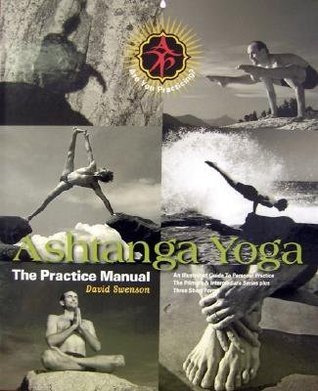
View On WordPress
#Ashtanga Yoga#Book Of The Day#book recommendation#book review#bookstagram#booktok#Primary Series#Raffaello Palandri#Raffaello Palandri Yoga Teacher#Yoga#Yoga Teacher
9 notes
·
View notes
Text
What Are the Benefits of Yoga for a Person's Physical Health?
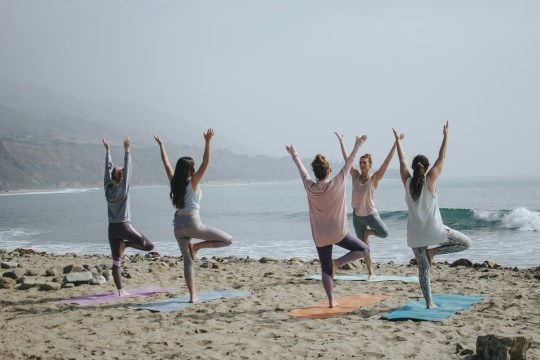
Yoga, an ancient practice with roots in India, has transcended its spiritual origins to become a mainstream form of exercise. While many associate yoga with flexibility and pretzel-like poses, its benefits extend far beyond that. Yoga offers a well-rounded approach to physical health, promoting strength, balance, and a range of other positive outcomes. Whether you're a seasoned athlete or a complete beginner, yoga can be a valuable addition to your fitness routine.
Building Strength and Muscle Tone
Yoga postures, or asanas, engage various muscle groups throughout the body. Holding these poses for sustained periods isometrically strengthens the muscles, leading to improved tone and definition. Unlike weightlifting, which can isolate specific muscle groups, yoga works the entire body in a more holistic manner. This is particularly beneficial for beginners, as it helps build a foundation of overall strength.
Strength Benefits:
Improved core strength, leading to better posture and stability.
Increased upper body strength, beneficial for daily activities.
Stronger lower body muscles can improve balance and gait.
Many yoga styles, such as Vinyasa and Ashtanga, incorporate movement sequences that build strength and endurance. These dynamic flows can be a great way to challenge yourself and build a stronger physique.
Enhancing Flexibility and Range of Motion
One of the most well-known benefits of yoga is its ability to improve flexibility. Yoga poses target tight muscles and connective tissues, gradually increasing their range of motion. This not only improves your ability to perform the poses themselves but also enhances your overall mobility and reduces the risk of injury in daily activities.
Flexibility Benefits:
Increased range of motion in the shoulders, hips, and spine.
Improved ability to bend and twist, enhancing daily activities.
Reduced muscle stiffness and tension.
Yoga for beginners focuses on gentle stretches and modifications, ensuring you don't push yourself beyond your limits. As you progress, you'll find yourself becoming more flexible and able to explore more challenging poses.
Improving Balance and Coordination
Yoga poses often require you to maintain balance on one leg or with different parts of your body in contact with the ground. This constant focus on balance translates to improved stability in everyday life, reducing the risk of falls, especially for older adults. Additionally, yoga sequences that involve transitioning between poses enhance coordination and proprioception, or your body's awareness of its position in space.
Balance and Coordination Benefits:
Increased stability and reduced risk of falls.
Improved proprioception for better body awareness.
Enhanced coordination for daily activities and exercise routines.
Many yoga classes incorporate balancing poses, even for beginners. These poses can be modified with props like blocks or straps to make them more accessible. As you gain confidence, you can progress to more challenging balancing exercises.
Maintaining a Healthy Spine and Posture
Yoga emphasizes proper alignment throughout the practice. Holding poses with a straight spine and engaged core muscles strengthens the back and improves posture. This can alleviate back pain caused by slouching or poor posture, promoting a healthier spine and better overall body mechanics.
Spine and Posture Benefits:
Strengthened core muscles for better spinal support.
Improved posture, reducing back pain and discomfort.
Increased flexibility in the spine for a better range of motion.
Yoga for beginners often focuses on poses that promote proper spinal alignment. As you progress, you can explore more challenging backbends and inversions that further strengthen and improve spinal health.
Benefits Beyond the Physical: Stress Reduction and Relaxation
While the physical benefits of yoga are significant, its impact extends beyond the body. Yoga incorporates breathing exercises (pranayama) and meditation techniques that promote relaxation and stress reduction. By focusing on your breath and calming your mind, yoga can help manage stress hormones, leading to a feeling of well-being and improved overall health.
Stress Reduction and Relaxation Benefits:
Reduced stress hormones like cortisol.
Improved sleep quality.
Enhanced sense of well-being and relaxation.
Many yoga classes incorporate periods of relaxation and meditation, even for beginners. These practices can be a valuable tool for managing stress in everyday life.
Yoga for Everyone: Modifications and Accessibility
One of the beauties of yoga is its adaptability. Yoga poses can be modified for all fitness levels and physical limitations. Whether you're a beginner, recovering from an injury, or have limited mobility, there's a yoga practice for you.
Many yoga studios offer beginner-friendly classes that focus on foundational poses and proper alignment. Additionally, there are numerous online resources and yoga for beginners programs that cater to specific needs and limitations.
2 notes
·
View notes
Text
Join 100hours Ashtanga Yoga Teacher Training in Goa, India with Oorjayii Yoga!
A 100-hour Ashtanga Yoga Teacher Training (AYTT) is a comprehensive program designed to provide participants with a strong foundation in the practice and teaching of the Ashtanga Yoga Primary Series.
Overview of Ashtanga Yoga Introduction to Ashtanga Yoga, its history, and lineage Understanding the philosophy and principles of Ashtanga Yoga Exploring the Eight Limbs of Yoga as outlined by Patanjali
Asana Practice In-depth study and practice of the Primary Series of Ashtanga Yoga Proper alignment, technique, and modifications for each asana Sequencing and structure of the Ashtanga Yoga series
Breath and Movement Synchronization Introduction to Vinyasa, the linking of breath and movement Understanding the importance of breath in Ashtanga Yoga Exploring the concept of Bandhas (energy locks) and their application
Ashtanga Yoga Philosophy Exploring the philosophical foundations of Ashtanga Yoga Study of key yogic texts such as the Yoga Sutras of Patanjali
Anatomy and Physiology Understanding the concepts of self-discipline, self-study, and surrender Anatomy and Physiology Basic anatomy and physiology relevant to Ashtanga Yoga Understanding the movement and mechanics of the body in the asanas Injury prevention and modifications for different body types
Adjustments and Assists Techniques for safe and effective adjustments and assists in Ashtanga Yoga Developing sensitivity and awareness in providing hands-on assistance Ethical considerations and boundaries in physical touch
Teaching Methodology Principles of effective teaching in Ashtanga Yoga Developing clear and concise verbal cues and instructions Sequencing and structuring a class in the Ashtanga tradition
Pranayama and Meditation Introduction to pranayama (breathing techniques) and its role in Ashtanga Yoga Yoga Ethics and Lifestyle Techniques for developing a steady breath and cultivating prana (life force) Introduction to meditation and its integration into the practice and teaching
Practicum and Teaching Practice Opportunities for supervised teaching practice Providing and receiving feedback on teaching skills Developing confidence and presence as a yoga teacher
Yoga Ethics and Lifestyle Understanding the ethical guidelines and principles of being a yoga teacher Exploring the concept of Ahimsa (non-violence) and its application in daily life Incorporating yogic principles into personal and professional life
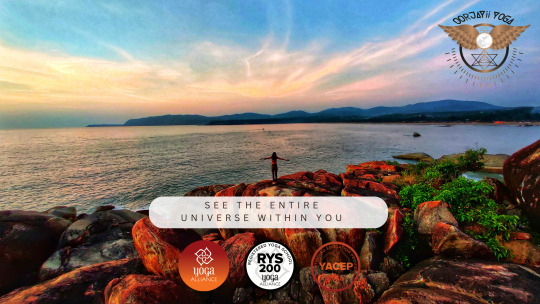
#yogatraining#yogastudent#meditation#yogaretreat#yoga#yogateachertraining#love#vinyasa#healthylifestyle#nature#goa#india#history#culture#sea#beach#today i learned#health & fitness#mental helath#helathyfood
7 notes
·
View notes
Text
Discover Your Inner Yogi: 31 Essential Poses for Beginners to Practice at Home
Embarking on the path of yoga is a fantastic decision for numerous reasons.
Beyond the physical benefits of increased strength, flexibility, and balance, yoga serves as a powerful tool for stress reduction through specialized breathing techniques known as pranayama.
Yoga is diverse, offering various poses to cater to different needs.
Now, let's delve into the joy of yoga with a focus on 31 essential poses for beginners to practice at home. These foundational poses not only serve as a physical workout but also contribute to mental well-being.
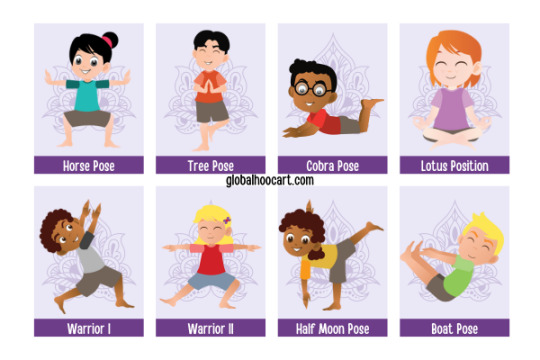
1. Downward Facing Dog (Adho Mukha Svanasana): A classic yoga pose that can be tricky for beginners, emphasizing weight distribution and heel stretching.
2. Mountain Pose (Tadasana): Equally important as Downward Facing Dog, it focuses on alignment, grounding, and spine lengthening.
3. Warrior I (Virabhadrasana I): A standing pose emphasizing forward-facing hips, crucial for building strength.
4. Warrior II (Virabhadrasana II): Similar to Warrior I but with hips facing the side, promoting openness and strength.
5. Extended Side Angle (Utthita Parvakonasana): Involving a modification for beginners, it offers a gentle stretch with forearm support.
6. Triangle Pose (Utthita Trikonasana): Another essential pose, engaging leg strength and enhancing flexibility in multiple areas.
7. Standing Forward Bend (Uttanasana): An easy pose for beginners, promoting spine flexibility and relaxation.
8. Reverse Warrior (Viparita Virabhadrasana): Combining a stance similar to Warrior I with a gentle side bend or backbend.
9. Garland Pose (Malasana): A squatting pose that stretches muscles around the pelvis, beneficial for hip flexibility.
10. Half Forward Bend (Ardha Uttanasana): Also known as Flat-Back Forward Bend, it contributes to improving overall body awareness.
11. Pyramid Pose (Parsvottanasana): A standing forward bend made more accessible for beginners with the use of yoga blocks.
12. Raised Hands Pose (Urdhva Hastasana): Starting from Mountain pose, it offers a full-body stretch, ideal for beginning your practice.
13. Low Lunge: A standing pose emphasizing proper alignment for a beneficial stretch, with modification options for support.
14. Tree Pose (Vrksasana): An excellent introduction to balancing postures, encouraging stability and mindfulness.
15. Downward Facing Dog Split: A basic yoga pose for beginners focusing on core strength and balance.
16. Plank Pose: Not just a balancing pose but a fundamental exercise for building core strength and stability.
17. Cat-Cow Stretch (Chakravakasana): A gentle backbend sequence enhancing body awareness, especially beneficial for beginners or those with back pain.
18. Bridge Pose (Setu Bandha Sarvangasana): A gentle backbend for beginners, enhancing spine extension and countering the effects of prolonged sitting.
19. Cobra Pose (Bhujangasana): A fundamental backbend that strengthens back muscles and promotes flexibility.
20. Knees, Chest, and Chin (Ashtanga Namaskara): An essential part of the sun salutation series, serving as an alternative to Chaturanga Dandasana.
21. Staff Pose (Dandasana): A seated version of Mountain pose, offering alignment guidance for various seated poses.
22. Cobbler's Pose (Baddha Konasana): A comfortable stretch for inner thighs, often using props for support.
23. Easy Pose (Sukhasana): A cross-legged sit made more comfortable with props, promoting flexibility and undoing the effects of prolonged chair sitting.
24. Half Lord of the Fishes Pose (Ardha Matsyendrasana): A seated twist benefiting spinal mobility and aiding digestion.
25. Head to Knee Pose (Janu Sirsasana): Easier than traditional forward bends, offering a gentle stretch one leg at a time.
26. Seated Forward Bend (Paschimottanasana): A fantastic hamstring stretch targeting the entire back of the body.
27. Seated Wide Angle Straddle (Upavistha Konasana): A wide-legged forward bend providing a unique stretch and focusing on proper form.
28. Happy Baby Pose (Ananda Balasana): Balancing effort and ease, this delightful pose offers a gentle stretch for the back, hips, thighs, and ankles.
29. Supine Spinal Twist (Supta Matsyendrasana): A passive twist promoting flexibility, relaxation, and a sense of completion to your practice.
30. Child's Pose (Balasana): A resting pose that allows you to take a break whenever needed, promoting a gentle stretch and relaxation.
31. Corpse Pose (Savasana): A serene conclusion to your session, allowing a smooth transition from the yoga mat to the rest of your day.
In conclusion, these 31 basic yoga poses for beginners at home offer a comprehensive and accessible introduction to the joy of yoga. Remember, yoga is for everyone, and the journey is as important as the destination. Enjoy the practice, embrace self-awareness, and savor the harmonious blend of effort and relaxation that yoga brings to your life.
4 notes
·
View notes
Text
Empower Your Body and Mind: Yoga Classes for Wellness
In a world that often feels chaotic and demanding, finding a sense of balance and inner peace is essential. One ancient practice that has stood the test of time and continues to be a source of physical and mental well-being is yoga. Yoga is not just a form of exercise; it's a holistic approach to wellness that empowers your body and mind. In this blog, we'll explore the transformative power of yoga and how enrolling in yoga classes near new york ny can be a profound step towards achieving overall wellness.
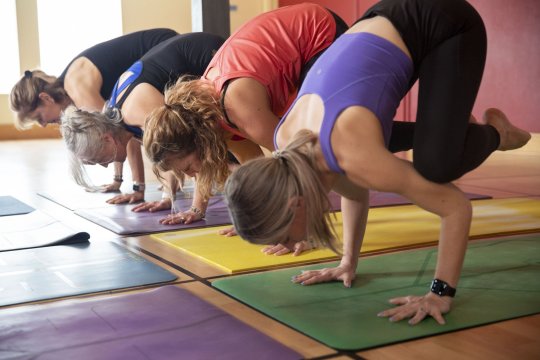
The Multifaceted Benefits of Yoga
Yoga is more than just stretching and bending; it's a practice that encompasses physical postures, breathing techniques, meditation, and mindfulness. Here are some of the multifaceted benefits that yoga can offer:
Improved Flexibility: Yoga postures, or asanas, gently stretch and lengthen muscles, promoting flexibility and range of motion. Over time, this can lead to reduced stiffness and greater physical freedom.
Enhanced Strength: Many yoga poses engage various muscle groups, helping to build and tone your body. You'll be surprised at the strength you can develop through yoga.
Stress Reduction: The deep breathing and meditation aspects of yoga are effective tools for managing stress. They promote relaxation and a sense of calm, reducing the production of stress hormones.
Better Posture: Yoga encourages awareness of your body's alignment, leading to improved posture. This can alleviate back pain and other discomforts caused by poor posture.
Mental Clarity: Practicing mindfulness and meditation in yoga can enhance your mental focus and clarity. It can also reduce anxiety and improve your overall mental health.
Weight Management: Yoga can help in weight loss or weight maintenance by increasing awareness of your body's needs and fostering healthy eating habits.
Improved Sleep: The relaxation techniques in yoga can help you get a better night's sleep. By calming the mind and reducing stress, it's easier to fall asleep and stay asleep.
Boosted Immune System: Yoga stimulates the body's lymphatic system, supporting immune function and helping to prevent illness.
Enhanced Respiratory Health: Breathing techniques (pranayama) in yoga improve lung function and help you to breathe more efficiently. This can be particularly beneficial for individuals with respiratory conditions.
Increased Mind-Body Connection: Yoga encourages a deeper connection between your body and mind. It teaches you to listen to your body's signals and respond to its needs.
Choosing the Right Yoga Classes Near NY
While practicing yoga on your own can be beneficial, enrolling in yoga classes near me can take your practice to the next level. There are various styles of yoga, and the right one for you will depend on your individual goals and preferences. Here are a few popular styles:
Hatha Yoga: A gentle introduction to the most basic yoga postures. It's a good place to learn beginners' poses with an emphasis on alignment and breathing.
Vinyasa Yoga: Characterized by the synchronization of breath with a continuous flow of postures, Vinyasa is dynamic and offers a cardiovascular workout.
Ashtanga Yoga: A fast-paced, intense style of yoga that follows a specific sequence of postures and is similar to Vinyasa yoga but more structured.
Bikram Yoga: Involves a series of 26 challenging poses practiced in a room heated to a high temperature. This promotes flexibility and detoxification.
Iyengar Yoga: Focuses on precise alignment and the use of props to support poses. It's excellent for those looking to improve their alignment and strength.
Yin Yoga: A slow-paced style with poses held for longer periods, Yin yoga targets the connective tissues in the body and helps release tension and improve flexibility.
Kundalini Yoga: An ancient form of yoga that combines postures, breathing techniques, and meditation to activate and balance the body's energy centers.
Restorative Yoga: A gentle, therapeutic style of yoga that uses props to support the body in deep relaxation. It's ideal for stress relief and recovery.
The Transformative Experience of Yoga Classes
Enrolling in yoga classes can be a transformative experience that empowers both your body and mind. The guidance of an experienced instructor, the support of a like-minded community, and the structured approach of classes can help you unlock the full potential of your yoga practice.
As you progress in your yoga journey, you'll notice positive changes in your physical health and mental well-being. Your body will become more flexible and strong, and you'll develop a greater sense of self-awareness and mindfulness. Stress and anxiety will gradually fade, making way for a more relaxed and focused mind.
In addition to the physical and mental benefits, yoga has a profound way of connecting us to our inner selves and to the world around us. It fosters a sense of harmony and balance, empowering us to face the challenges of life with a greater sense of serenity and resilience.
Conclusion
Yoga is a powerful practice that can empower your body and mind. Its numerous benefits extend far beyond the physical, providing a pathway to a more balanced and harmonious life. Enrolling in yoga classes is an excellent way to embark on this transformative journey, guided by experienced instructors and surrounded by a supportive community.
Whether you're a beginner seeking to improve your flexibility or an experienced yogi looking to deepen your practice, there is a yoga class that's right for you. By embracing the practice of yoga, you can discover a profound sense of wellness and inner peace that will positively impact every aspect of your life. So, take the first step towards empowerment and well-being – enroll in a yoga class and embark on your own journey to a healthier, happier you.
#yogapractice#yoga classes#online yoga classes#yogaeveryday#yogaposes#yogainspiration#yogateacher#wellness#mindfulliving#yogamotivation#meditation practice
2 notes
·
View notes
Text
The Best Yoga Teacher Training in Rishikesh India 2024
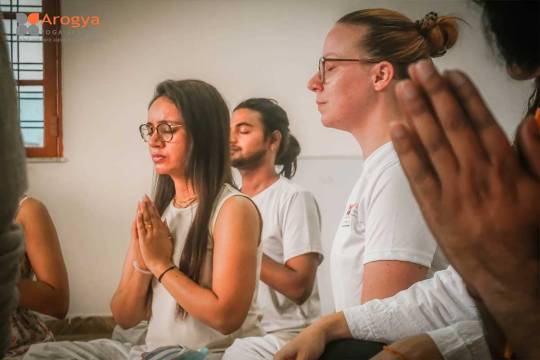
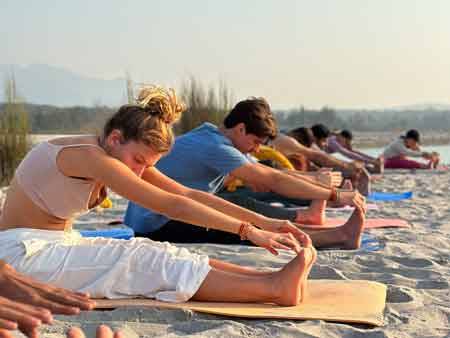
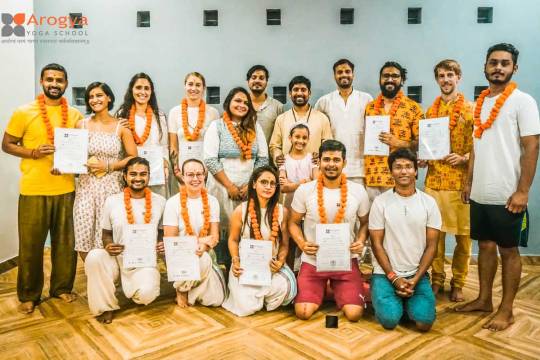

Hatha and Ashtanga Yoga Teacher Training Course at Arogya Yoga School, Rishikesh. Certified by Yoga Alliance USA
If you are looking to bring a change into your life by learning yoga for self-rejuvenation or transfer the benefits to others, by getting a professional certificate and expertise, then Arogya Yoga School is the perfect fit for you.
✅200 Hour Yoga Teacher Training in Rishikesh ➤Just 700 USD With Food and Accommodation.
🗓️ 02 To 25 Oct 2023 : Book Now
🗓️ 02 To 25 Nov 2023 : Book Now
🗓️ 02 To 25 Dec 2023 : Book Now
🗓️ 02 To 25 Jan 2024 : Book Now
More Details: https://www.arogyayogaschool.com/
Call/ Whats App: +91-8630677119
Highlights
Morning and evening yoga class
One special session of Ayurveda
One Free sound healing session.
Daily fresh and healthy organic vegetarian/vegan/gluten-free meals
Daily mantra chanting, asana, yoga anatomy, and yoga philosophy
Eligible to register with Yoga Alliance upon completion
Free Yoga Manual Book.
24 nights' accommodation with 3 meals daily
Course objectives
Develop your personal daily practice
One Sound Healing Session.
Develop and practice daily pranayama, Kriyas, Mudras, and meditation
Learn about the skeletal and muscular systems and how this affects your practice and teaching
Study the Patanjali's Yoga Sutras and learn how to incorporate them into your daily practice and life
Learn how to structure a class and then incorporate all these components into designing your own class
Learn to teach this class to your peers in a small group environment and then you will teach this class to your peers as your assessment
Included excursions
You will enjoy weekend excursions on Saturday evenings and Sundays, to make the most of your time off classes.
What's included
24 nights' accommodation
Daily 3 meals nutritious vegetarian meals and herbal tea
Weekend excursions
Course materials will be provided (notebooks, yoga mat, cleansing kit)
1 sound healing session
Outdoor yoga session
1 sightseeing tour
Kirtan
Certificate of completion
Practice teaching, learn how to sequence your first yoga class and teaching tools
Herbal teas
Excursions on Sunday
Yoga Teacher Training Arogya manual
✅300 Hour Yoga Teacher Training in Rishikesh ➤Just 999 USD
🗓️ 02 To 28 Oct 2023 : Book Now
🗓️ 02 To 28 Nov 2023 : Book Now
🗓️ 02 To 28 Dec 2023 : Book Now
🗓️ 02 To 28 Jan 2024 : Book Now
#yoga#education#igyoga#yogaeverywhere#yogalove#home & lifestyle#yogainspiration#yogateacher#yogacourses#yoga in rishikesh#yoga courses in india#ashtanga yoga#hatha yoga teacher training in rishikesh#health is wealth
4 notes
·
View notes
Text
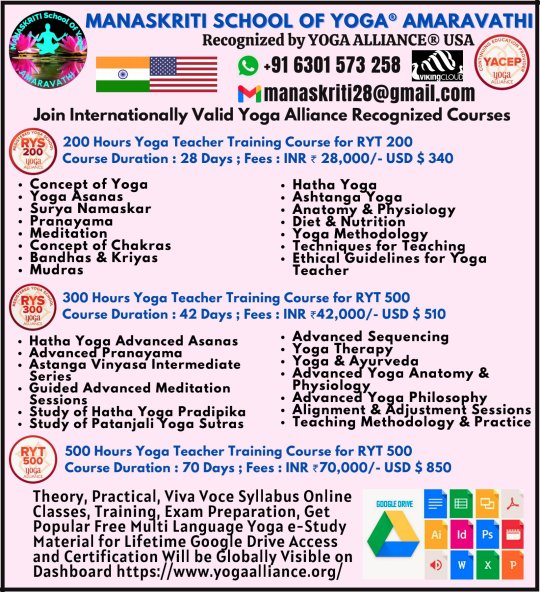
NAMASTHE 🙏🏻
MANASKRITI SCHOOL OF YOGA® AMARAVATHI
Recognized by YOGA ALLIANCE® USA
Join Internationally Valid Yoga Alliance Recognized Courses
200 Hours Yoga Teacher Training Course for RYT 200
Course Duration : 28 Days ; Fees :INR ₹28,000/- USD $340
300 Hours Yoga Teacher Training Course for RYT 500
Course Duration : 42 Days ; Fees : INR ₹42,000/- USD $510
500 Hours Yoga Teacher Training Course for RYT 500
Course Duration : 70 Days ; Fees : INR ₹70,000/- USD $850
Theory, Practical, Viva Voce Syllabus Online Classes, Training, Exam Preparation, Get Popular Free Multi Language Yoga e-Study Material for Lifetime Google Drive Access and Certification Will be Globally Visible on Dashboard https://www.yogaalliance.org/
For more Info ℹ
_____________💮
______________🧘🏻♀️
*Manaskriti*
Certified RYT 500 hrs Virginia USA
*📱+91 6301 573 258*
📍 *MANASKRITI SCHOOL OF YOGA*
#ManaskritiYoga #ManaskritiOnline
#PatanjaliAYTT #CertificateCourse
#WomenHealth #YogaEducation
#InternationalYoga #Yoga #Ayurveda
#YogaTeacherTraining #RYS200hrs
#YogaTherapy #RYS500hrs
#YogaPractice #YogaFacts #YogaPoses
#YogaMat #YogaPractice
#YogaInspiration #YogaMotivation
Online Teaching and Teacher Training
As the world continues to transition to more and more online connection and engagement, so does the teaching and practice of yoga. To meet the needs of the broader yoga community and evolution of the times, Yoga Alliance uses sound research, data, and proven methodologies to adapt its standards to the online environment.
Due to sweeping changes in the yoga industry, many classes and trainings are moving online. To support this transition, we have compiled a variety of online teaching best practices, tools, and resources for members to leverage. Members also have the option to display online offerings and closed-captioning capabilities to their YA profiles for directory users to easily find.
Yoga Alliance is a nonprofit 501(c)(6). Yoga Alliance Foundation is a nonprofit 501(c)(3). This website refers to the two organizations as "Yoga Alliance." Copyright 2023 Yoga Alliance. Yoga Alliance, the Yoga Alliance logo, RYS, RYT, and YACEP are registered marks with the USPTO and other jurisdictions.
Syllabus :
Concept of Yoga
Yoga Asanas
Surya Namaskar
Pranayama
Meditation
Concept of Chakras
Bandhas & Kriyas
Mudras
Hatha Yoga
Ashtanga Yoga
Anatomy & Physiology
Diet & Nutrition
Yoga Methodology
Techniques for Teaching
Ethical Guidelines for Yoga Teacher
Hatha Yoga Advanced Asanas
Advanced Pranayama
Astanga Vinyasa Intermediate Series
Guided Advanced Meditation Sessions
Study of Hatha Yoga Pradipika
Study of Patanjali Yoga Sutras
Advanced Sequencing
Yoga Therapy
Yoga & Ayurveda
Advanced Yoga Anatomy & Physiology
Advanced Yoga Philosophy
Alignment & Adjustment Sessions
Teaching Methodology & Practice
2 notes
·
View notes
Text
Yoga
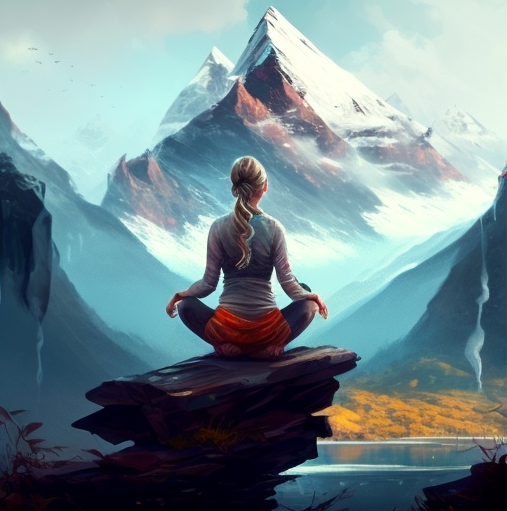
Introduction:
Yoga is an ancient practice that has been around for thousands of years. It originated in India and has since spread to many other parts of the world. Yoga is a holistic practice that includes physical postures, breathing exercises, and meditation. It is a powerful tool for improving overall health and well-being.
Table of Contents:
I. What is Yoga?
II. History of Yoga
III. Types of Yoga
IV. Health Benefits of Yoga
V. How to Get Started with Yoga
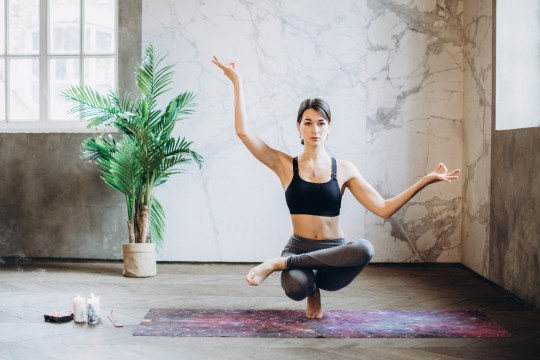
I. What is Yoga?
Yoga is a practice that includes physical postures, breathing exercises, and meditation. It is a holistic practice that aims to improve overall health and well-being. Yoga can help to improve flexibility, strength, balance, and endurance. It can also help to reduce stress and improve mental clarity.
II. History of Yoga
Yoga originated in ancient India more than 5,000 years ago. It was originally a spiritual practice that was used to help people reach enlightenment. Over time, yoga evolved to include physical postures and breathing exercises. Today, yoga is practiced all over the world and is used for a variety of purposes, including fitness and stress management.
III. Types of Yoga
There are many different types of yoga, each with its own unique focus and style. Some of the most popular types of yoga include:
Hatha Yoga: This type of yoga focuses on physical postures and breathing exercises. It is a good place to start for beginners.
Vinyasa Yoga: This type of yoga is also called flow yoga. It involves moving through a series of postures in a flowing sequence.
Ashtanga Yoga: This type of yoga is a more intense form of yoga that includes a set series of postures.
Iyengar Yoga: This type of yoga focuses on alignment and precision in the postures.
Kundalini Yoga: This type of yoga focuses on awakening the energy at the base of the spine.
Restorative Yoga: This type of yoga is a gentle practice that focuses on relaxation and stress reduction.
IV. Health Benefits of Yoga
Yoga has a wide range of health benefits, including:
Improved flexibility and strength
Reduced stress and anxiety
Improved cardiovascular health
Improved respiratory function
Improved balance and coordination
Improved mental clarity and focus
Improved sleep
Reduced chronic pain
V. How to Get Started with Yoga
If you're new to yoga, it's important to start with a class that is geared towards beginners. Look for a class that is labeled "beginner" or "gentle" and be sure to let the instructor know that you're new to yoga. They will be able to give you modifications and adjustments to help you get the most out of the class. It's also a good idea to invest in a yoga mat and comfortable clothing that allows you to move freely. Remember to listen to your body and take breaks if you need them. With regular practice, you'll start to see the benefits of yoga in your mind, body, and spirit.
Conclusion:
Yoga is a holistic practice that has been around for thousands of years. It includes physical postures, breathing exercises, and meditation and is used to improve overall health and well-being. Yoga can help to reduce stress, improve mental clarity, and reduce chronic pain. If you're new to yoga, it's important to start with a beginner class and listen to your body. With regular practice, you'll start to see the benefits of yoga in your mind, body, and spirit.
#helth and fitness#vintage cars#wildlife#yogatime#yogadite#yogafitness#yogalife#yogainmountain#healthy life happy life
6 notes
·
View notes
Video
Accepting applications for RYT 300Hr certification
Calling all Yoga lovers, body art healers, Life coaches and emerging Yoga Instructors We are very excited to announce that Bend it like Buddha Yoga school is now accepting applications for the Yoga Alliance accredited RYT 300 Hr yoga training cohort starting on April 4th! We want to personally invite you to upgrade your skills by joining the advanced 300Hr Advanced Vinyasa & Ashtanga Yoga Teacher Training along the gorgeous beach coastlines of Algarve, Portugal! During this hybrid 20 days yoga program, you will go deeper into yoga philosophy, alignment, mudras, learn how to facilitate sound healing and cacao ceremonies, how to facilitate Usui Reiki healing sessions and practice daily advanced pranayama. Highlights:-Daily advanced Vinyasa and Ashtanga yoga practice twice per day AM/PM or healing practice such as cacao ceremony or Tibetan bowl sound healing journey.-Traditional Ashtanga Vinyasa yoga lessons with Intermediate series postures;-Advanced Vinyasa sequencing and postures;-Advanced accredited Yoga Alliance RYT 300 yoga teacher training course 300-hour certificate in Ashtanga and Vinyasa-Daily philosophy classes: Bhagavad Gita, Upanishads, Patanjali Sutras meditation, heart healing intimacy exercises, inner child shadow workshops and profound Breath Work journeys-Acro, prenatal, kids yoga, Partner yoga, sound journey, traditional Kirtan Mantras, alignment, anatomy, trauma informed yoga therapy training, daily hands-on adjustment practice-Learn and practice how to teach advanced and tailored Vinyasa and Ashtanga classes each day 6 AMAZING BONUS:-Eight-hour Ayurveda therapy massage certificate;-Four-hour workshop on trauma-informed yoga principles;-Four-hour Nada yoga workshop, sound healing facilitator training, and cacao ceremony facilitator: best tips and recommendations for beginners and seasoned practitioners of Nada yoga / sound healing and cacao ceremony and learn how to conduct and hold space during your sound healings and ceremony for your future students.-Six-hour Usui Reiki level 1 training and certificate: if you have level one or two already, you will receive the next level training and attunement for the level you are at.-Learn how to facilitate and plan a breathwork journey for groups and practice advanced pranayama imparted by the Father of Modern Yoga Krishnamacharya, a student of BNS Iyengar based in Mysore, India.-Four-week yoga business lifestyle coaching: post-graduate support, weekly live training, accountability, and implementation labs to inspire you to take massive action to launch your micro yoga-niched brand to attract your dream students. Learn how to market your workshops and retreats utilizing the effective Online Yoga Challenge model taught by Bend it like Buddha Yoga school founder L. Farrah Furtado E RYT 500.The world is in great need of incredible yoga teachers, now more than ever, and it is RYS 200/RYS 300 Bend it like Buddha's purpose to impart the practice for sharing it, with as many people as possible to awaken, heal, and move beautiful souls into their dharma and purpose as we enter into the most pivotal spiritual transition on Earth in human history! Learning and successfully implementing this innovative and nuanced yoga challenge framework is a must for all yoga teacher entrepreneurs in order to survive and thrive in today's competitive yoga noisy world full of distractions...Together as a yoga family, in friendships, also fun, and in community support, you will thrive as you create a positive ripple effect on the planet. Through sharing yoga, you are all sowing fertile seeds of hope, good health, joy, and inner peace into a world in desperate need of hope and healing. Join this movement that is happening within the Bend it like Buddha yoga community to receive training and support while helping as many people as possible, through the profound and powerful practices of yoga, meditation, and pranayama Hurry, very limited spots!Namaste [email protected] for more info.....#yogateacher #yogaforlife #yogateacher300Hr #reikicourse #meditation #yogamom #yogaworkshop #Yoga #yogientrepreneur #yoginilife #yogalover #portugalretreats #healing #portugalyoga #yogateachertrainingadvanced #RYT300Hr #retreatalgarve #portugalyoga #vinyasayoga #transformation #meditationretreat #ayurvedamassage #yogaportugal #algarveretreat
2 notes
·
View notes
Text

The 200 Hour Yoga Teacher Training in Rishikesh offers a transformative journey for aspiring yogis, set against the serene backdrop of the Himalayas and alongside the sacred banks of the Ganges River. This rigorous program immerses participants in traditional yoga practices, including Hatha and Ashtanga styles, while emphasizing both physical postures (asanas) and philosophical teachings rooted in ancient scriptures. Students engage deeply with anatomy, alignment techniques, and meditation practices that foster personal growth and self-awareness. Each day is meticulously structured to include dynamic classes led by experienced instructors who share their wisdom through interactive sessions on teaching methodology and class sequencing. The tranquil atmosphere of Rishikesh not only enhances the learning experience but also encourages introspection amidst nature’s beauty, allowing practitioners to connect with their inner selves as they prepare to inspire others on their own paths toward wellness. With daily workshops that cover essential topics such as pranayama (breath control), mantra chanting, and the art of adjustments, this comprehensive training nurtures both seasoned practitioners seeking certification and newcomers eager to deepen their understanding of yoga's profound benefits.
0 notes
Text
Are you ready to connect your mind, body, and soul in a transformative way? 🧘♀️✨
Ashtanga Yoga is a dynamic and energizing practice that combines breath (pranayama) with movement (asanas) in a structured sequence. It’s perfect for building strength, flexibility, and inner peace. 🌿💪
Whether you’re a beginner or an experienced yogi, this journey will leave you feeling balanced, focused, and revitalized. 🌈
0 notes